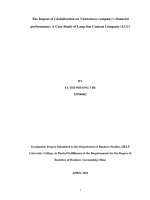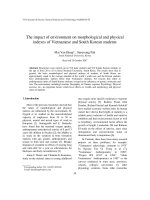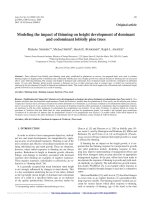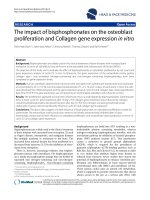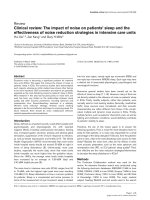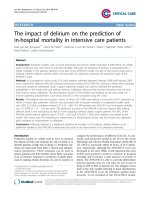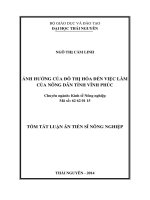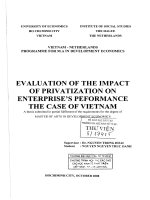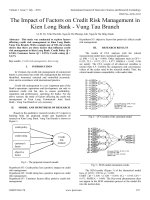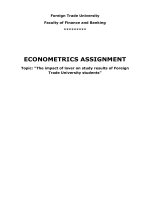The impact of litigation on neurologic research
Bạn đang xem bản rút gọn của tài liệu. Xem và tải ngay bản đầy đủ của tài liệu tại đây (159.04 KB, 3 trang )
Correspondence
CAN PATIENTS WITH EPILEPSY PREDICT
THEIR SEIZURES?
To the Editor: We read the article by Haut et al.
with interest.1 The authors report on the ability of
some patients with epilepsy to predict the occurrence of their seizures.
As suggested by the authors, this ability may
rely on prodromes or warning and initial symptoms. Preictal dysphoria is a phenomenon well
described by patients and their relatives, but the
frequency, duration, and clinical features have
been only occasionally investigated. The last systematic study specifically dedicated to this subject
was published in 1986.2
It is evident that mood changes preceding
the occurrence of seizures represent a neglected
area of research in epileptology and neuropsychiatry of epilepsy that, conversely, may have
important clinical implications. Research concerning seizure-alerting dogs is also of interest.3
It is possible that this phenomenon could be interlinked with preictal dysphoria—that dogs’
behaviors are influenced by specific mood
changes of the owner occurring in the preictal
phase.
It is now accepted that the end of the seizure is
not the end of the problem,4 but what precedes
the seizure can be equally interesting.
Marco Mula, MD, Francesco Monaco, MD,
Novara, Italy
Disclosure: The authors report no conflicts of interest.
Reply from the Authors: We appreciate the interesting comments by Drs. Mula and Monaco.
The role of mood changes preceding a seizure is
an intriguing issue that has received little recent
attention.
We agree that the ability of patients to successfully predict their seizures may well be related, at
least in part, to the emotional content of the preictal phase. Certainly this is an area of investigation that merits prospective evaluation, and one
that we plan to incorporate in our follow-up studies. Furthermore, the possible connection of
mood changes preceding a seizure and the abili494
Neurology 69
July 31, 2007
ties of seizure-alert dogs is intriguing and biologically plausible.
Sheryl R. Haut, Charles B. Hall, Aaron J.
LeValley, Richard B. Lipton, Bronx, NY
Disclosure: The authors report no conflicts of interest.
Copyright © 2007 by AAN Enterprises, Inc.
1.
2.
3.
4.
Haut SR, Hall CB, LeValley AJ, Lipton RB. Can patients with epilepsy predict their seizures? Neurology
2007;68:262–266.
Blanchet P, Frommer GP. Mood change preceding epileptic seizures. J Nerv Ment Dis 1986;174:471– 476.
Strong V, Brown SW, Walker R. Seizure-alert dogs:
fact or fiction? Seizure 1999;8:62– 65.
Kanner AM, Soto A, Gross-Kanner H. Prevalence and
clinical characteristics of postictal psychiatric symptoms in partial epilepsy. Neurology 2004;62:708 –713.
ENCEPHALOPATHY, STROKE, AND
MYOCARDIAL INFARCTION WITH DMSO USE
IN STEM CELL TRANSPLANTATION
To the Editor: The topical report by ChenPlotkin et al. shows the probable role of DMSO in
complications due to stem cell transplantation.1
This is analogous to encephalopathy induced by
propylene glycol-containing IV drugs.2
In the case of DMSO, this could have been
caused by metabolic formation of sulfite which is
harmful, for example to mitochondria and heme
synthesis.3
With new therapeutic methods, the toxicity of
excipients should be further investigated so that
the positive effects of treatment are not lost.
Heikki Savolainen, Tampere, Finland
Disclosure: The author reports no conflicts of interest.
Reply from the Authors: We thank Dr. Savolainen for the comments on our article. The
phenomenon we described of profound encephalopathy during or shortly after DMSO infusion
implies a toxic effect without indicating a clear
mechanism. However, the myocardial and cerebral infarcts suggest additional vascular ischemic
causes, which are different from the metabolic effects described in propylene glycol toxicity. Work
in an animal model using selective injections of
various solvents into the swine equivalent of the
carotid artery (rete mirabile) has demonstrated
that DMSO, more than similar solvents (DMI,
ethyl lactate, glycofurol 74, NMP, and solketal)
may cause prolonged vasospasm.4 We postulate
that this vasospasm, in turn, may result in ischemia and infarction of tissue.
Alice S. Chen-Plotkin, Keith A. Vossel, Martin
A. Samuels, Ming Hui Chen, Boston, MA
Disclosure: The authors report no conflicts of interest.
Copyright © 2007 by AAN Enterprises, Inc.
1.
2.
3.
4.
Chen-Plotkin AS, Vossel KA, Samuels MA, et al. Encephalopathy, stroke and myocardial infarction with
DMSO use in stem cell transplantation. Neurology
2007;68:859 – 861.
Wilson KC, Reardon C, Theodore AC, et al. Propylene
glycol toxicity: a severe iatrogenic illness in ICU patients receiving IV benzodiazepines. Chest 2005;128:
1674 –1681.
Savolainen H, Tenhunen R. Inhibition of heme synthase in brain and liver by low-level peroral sulfite exposure. Res Commun Chem Pathol Pharmacol 1982;
36:511–514.
Dudeck O, Jordan O, Hoffmann KT, et al. Organic
solvents as vehicles for precipitating liquid embolics: a
comparative angiotoxicity study with superselective injections of swine rete mirabile. Am J Neuroradiol 2006;
27:1900 –1906.
THE IMPACT OF LITIGATION ON
NEUROLOGIC RESEARCH
To the Editor: Racette et al. complain that litigation interferes with scientific research.1 Unfortunately, their article offers a one-sided, incomplete
picture of the interaction between scientific research and the law, and their proposals are illconsidered.
Although the authors complain about the expense incurred in responding to subpoenas for
data underlying their Alabama study, they fail to
disclose that the welder screenings for their study
were funded by plaintiffs’ attorneys as part of an
effort to solicit personal-injury clients.2 Defendants served subpoenas to obtain the study’s underlying data only after plaintiffs’ counsel heavily
relied on the study in the litigation. Contrary to
their minimal disclosure, the authors were not
disinterested researchers inadvertently caught up
in litigation. The authors collaborated with plaintiffs’ counsel so closely that counsel invoked litigation privileges to cloak the work in secrecy.
The authors also fail to mention that much of
the cost of complying with the subpoenas resulted
from their own actions. The subpoenas were
served with offers to redact individual identifiers,
reimburse reasonable expenses, and to agree to
nondisclosure and nonpublication of data. The
authors spurned these offers, and filed briefs seek-
ing to block all access. The Court, after carefully
weighing all parties’ interests, required production of limited, redacted data, with compensation
for reasonable expenses, as originally offered.
The costs complained of were largely selfinflicted.
Basic norms of science favor openness and discourage secrecy in research. The scientific community has increasingly demanded transparency
from investigators. Many leading journals require
raw data and questionnaires to be submitted, either in peer-review or upon acceptance. Research
funded by the NIH is subject to federal law that
makes underlying data subject to public disclosure,3 and the National Research Council has
urged sharing research data, especially when relevant to public policy.4
As demonstrated in the welding cases, judges
appropriately have discretion to protect researchers’ legitimate interests, while ensuring that litigants can discover and examine studies that may
be offered against them.
The authors’ proposals would chill participation by outstanding senior academic physicians
and create vacuums in courtrooms, which will be
filled by less-qualified witnesses. The proposals
undermine physicians’ civic obligations to provide their expertise, properly compensated, to all
participants in the judicial system.5 Finally, the
authors’ vague proposal to limit industrysponsored support for specific projects threatens
to prevent companies from funding research, a
demand often made by the very plaintiffs’ lawyers
who supported Dr. Racette’s work.
Nathan A. Schachtman, Philadelphia, PA
Disclosure: Nathan A. Schachtman is a member of McCarter
& English LLP, Philadelphia, PA. Mr. Schachtman, in his
capacity as legal counsel for welding defendants, was responsible for serving the subpoenas discussed in the editorial
piece by Drs. Racette and Perlmutter, and their legal counsel.
He has prepared and tried hundreds of cases involving epidemiologic data, involving various disease outcomes, including
neurologic diseases and disorders. The opinions in this letter
are his, and not necessarily those of his clients or his firm.
Reply from the Authors: We appreciate Mr.
Schachtman’s interest in our recent article. However, it is important to point out the errors included in his letter. Mr. Schachtman inaccurately
alleges that we provided “minimal disclosure”
and collaborated with plaintiffs’ counsel.6
As originally disclosed in our article,2 our University was paid by attorneys to perform medical
screenings in Alabama of patients exposed to
welding. The data that we collected were subsequently retrospectively examined and the results
Neurology 69
July 31, 2007
495
published. There was no funding or collaboration
with attorneys as to any aspect of the design, execution, or publication of the study.
Furthermore, Mr. Schachtman suggests that
plaintiffs’ counsel’s invocation of privileges for
patients who did not file lawsuits proves an illicit
collaboration between plaintiffs’ counsel and our
research team. Various legal privileges protect patients’ medical data (see, e.g., 10 A.L.R. 4th 552,
Wakefield WE. Physician-patient privilege as extending to patient’s medical or hospital records;
2007). Pleadings filed in the multidistrict litigation indicate that none of the Alabama patients
we examined became plaintiffs in the multidistrict litigation.
The patient data demanded by the welding defendants’ subpoenas related entirely to patients
who were not plaintiffs in the underlying litigation. Counsel for these patients who did not file
suit legitimately asserted litigation privileges to
protect their medical data. Seeking protection of
applicable privileges is procedural for lawyers
and not evidence of a conspiracy.
Mr. Schachtman stretches credibility by asserting that much of the cost of complying with subpoenas resulted from our “own actions.” His
suggestion that we could have avoided litigation
costs and simply complied with his clients’ subpoenas is, and was, an unacceptable outcome, in a
case where neither the University nor its researchers are parties or designated experts. He and his
clients’ primary interest in this research are to discredit it in a court of law, which is neither the
forum nor the outcome we could abide willingly.
Mr. Schachtman’s clients served subpoenas
found by a United States District Judge to be
overbroad and burdensome. A few examples included copies of all patient videos; all grant applications by study authors; all drafts of the
published version of the study; all editor and peer
review comments to drafts of the study; and all
data analyses outputs.2,6 Failing to object to these
unreasonable requests would have consumed
greater resources, jeopardized patient confidentiality, and further delayed future research.
Mr. Schachtman naively equates the peerreview system and scientific openness with legal
review of data by medical experts paid large sums
of money to discredit research. The former advances science and brings needed treatments to
patients. The intent of the latter frequently is to
496
View publication stats
Neurology 69
July 31, 2007
intimidate scientists from pursuing new avenues
of research that might prove detrimental to one
side of a lawsuit. Reasonable limitations on access to researchers’ time and data would prevent
investigators from abandoning promising research leads. However, researchers must also take
responsibility for their actions and decide if their
own personal gain trumps patients’ interests.
Despite Mr. Schachtman’s claims to the contrary, it is reasonable to expect that a researcher
avoid personal financial conflicts when conducting research. We owe our patients acknowledgment of the problem and correction of this
abusive system.
Brad A. Racette, Ann Bradley, Carrie A.
Wrisberg, Joel S. Perlmutter, St. Louis, MO
Disclosure: After the publication of the abstract to a 2001
manuscript on welding, Dr. Racette provided consultation
and received personal compensation for one meeting each
with counsel representing defendants and plaintiffs for
welding-related medical matters not pertaining to any multidistrict litigation, for consulting compensation totaling
$2,000. Dr. Racette received $229,631 paid to Washington
University in St. Louis from the Welder Health Fund into an
account controlled by Dr. Racette. The Welder Health Fund
was created by Gulf States Trial Attorneys to support medical screening of welders for Parkinson disease.
Copyright © 2007 by AAN Enterprises, Inc.
1.
2.
3.
4.
5.
6.
7.
Racette BA, Bradley A, Wrisberg CA, Perlmutter JS.
The impact of litigation on neurologic research. Neurology 2006;67:2124 –2128.
Racette BA, Tabbal SD, Jennings D, Good L, Perlmutter JS, Evanoff B. Prevalence of parkinsonism and relationship to exposure in a large sample of Alabama
welders. Neurology 2005;64:230 –235.
Public Law 105–277 (1999) (requiring the Office of
Management and Budget to promulgate regulations
that required federal agencies awarding research contracts to ensure that “all data produced under a federal
award will be made available to the public”); see also
OMB Circular A-110, Uniform Administrative Requirements for Grants and Agreements with Institutions of Higher Education, Hospitals, and Other NonProfit Organizations, Federal Register 64:5684 (Feb. 4,
1999).
Fienberg SE, Martin ME, Straf ML. Sharing Research
Data. Washington, DC: National Academies Press,
1985.
American College of Physicians. Guidelines for the
Physician Expert Witness. Ann Intern Med 1990;113:
789.
United States District Court for the Northern District
of Ohio Eastern Division. MDL#1535, 2007.
United States District Court for the Eastern District of
Missouri, Eastern Division, 4:05MC165SNL, 2005.
